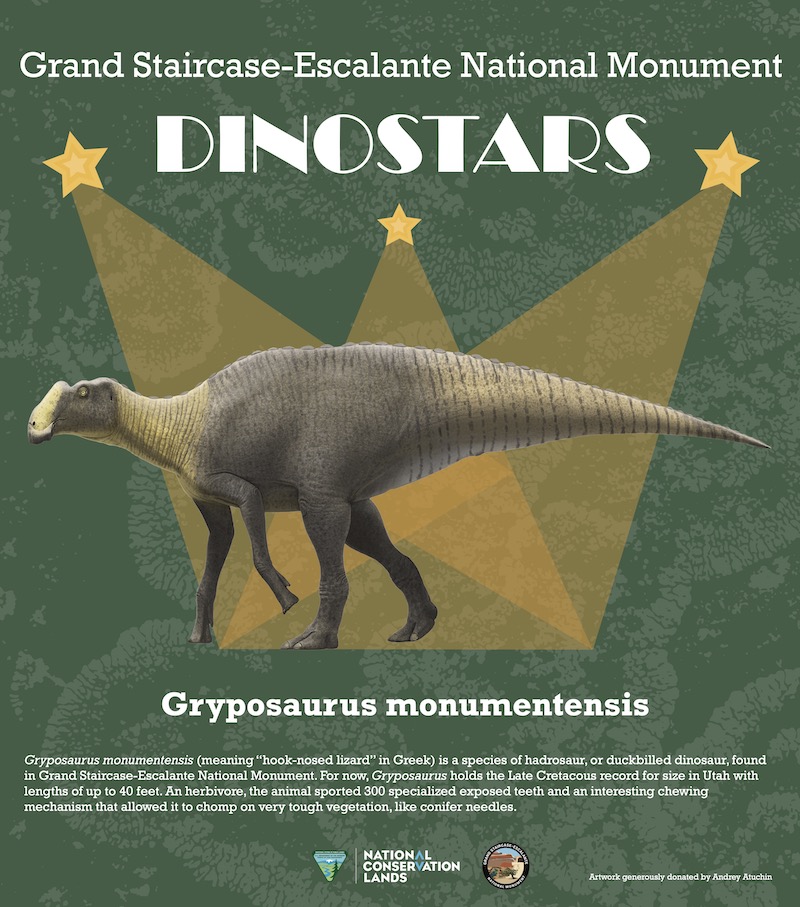Description
This dinosaur poster set includes 5 dino “stars” of Grand Staircase-Escalante National Monument. Each poster is 17.5″ x 24″.
Gryposaurus:
A genus of duckbilled dinosaur that lived about 83 to 74 million years ago, in the Late Cretaceous (late Santonian to late Campanian stages) of North America. Named species of Gryposaurus are known from the Dinosaur Park Formation in Alberta, Canada, and two formations in the United States: the Lower Two Medicine Formation in Montana and the Kaiparowits Formation of Utah.
Kosmoceratops:
A genus of ceratopsid dinosaur that lived in Utah about 76.4–75.5 million years ago during the Late Cretaceous period. Specimens were discovered in the Kaiparowits Formation of the Grand Staircase-Escalante National Monument in 2006 and 2007, including an adult skull and postcranial skeleton and partial subadults (between juvenile and adult). In 2010, the adult was made the holotype of the new genus and species Kosmoceratops richardsoni; the generic name means “ornate horned face”, and the specific name honors Scott Richardson, who found the specimens. The find was part of a spate of ceratopsian discoveries in the early 21st century, and Kosmoceratops was considered significant due to its elaborate skull ornamentation.
Nasutoceratops:
An extinct genus of a ceratopsian dinosaur. It is a basal centrosaurine that lived during the Late Cretaceous period (late Campanian, about 76.0-75.5 Ma). Fossils have been found in southern Utah, United StatesThe holotype was discovered and collected in 2006 during the Kaiparowits Basin Project, initiated by the University of Utah in 2000. It was recovered from channel sandstone from the middle unit of the upper Kaiparowits Formation within the Grand Staircase-Escalante National Monument, in sediment that dates to the late Campanian stage of the Cretaceous period, approximately 75 million years ago.
Teratophoneus:
AKA “monstrous murderer” is a genus of carnivorous tyrannosaurid theropod dinosaur which lived during the late Cretaceous period (late Campanian age, about 77 to 76 million years ago)
Fossils of Teratophoneus were first found in the Kaiparowits Formation of southern Utah. Later, fossils from the same formation were discovered and identified as the genus. Argon-argon radiometric dating indicates that the Kaiparowits Formation was deposited between 76.1 and 74.0 million years ago, during the Campanian stage of the Late Cretaceous period. This date means that Teratophoneus lived in the middle of the Campanian stage of the Late Cretaceous. Three different fossils of Teratophoneushave been found.
Talos sampsoni:
An extinct genus of a carnivorous bird-like theropod dinosaur, an advanced troodontid which lived during the late Cretaceous period (late Campanian, about 75.95 Ma) in the geographic area that is now Utah, United States.
It was discovered and collected in 2008 by M. J. Knell during the Kaiparowits Basin Project, initiated by the University of Utah in 2000, from the Kaiparowits Formation within the Grand Staircase-Escalante National Monument.
(shipping included)





